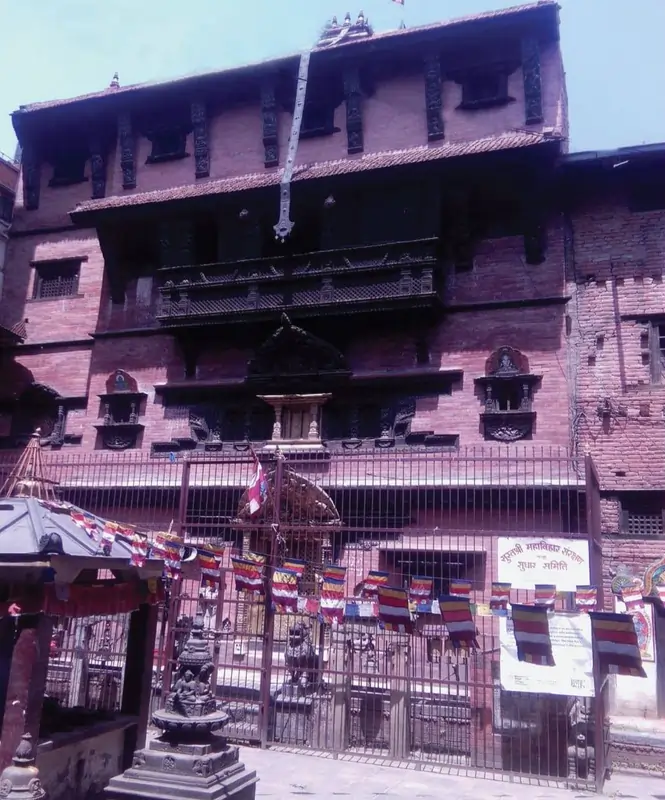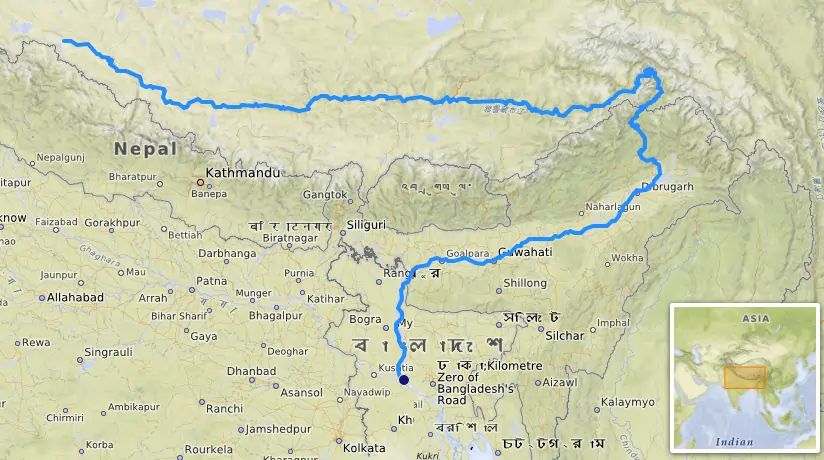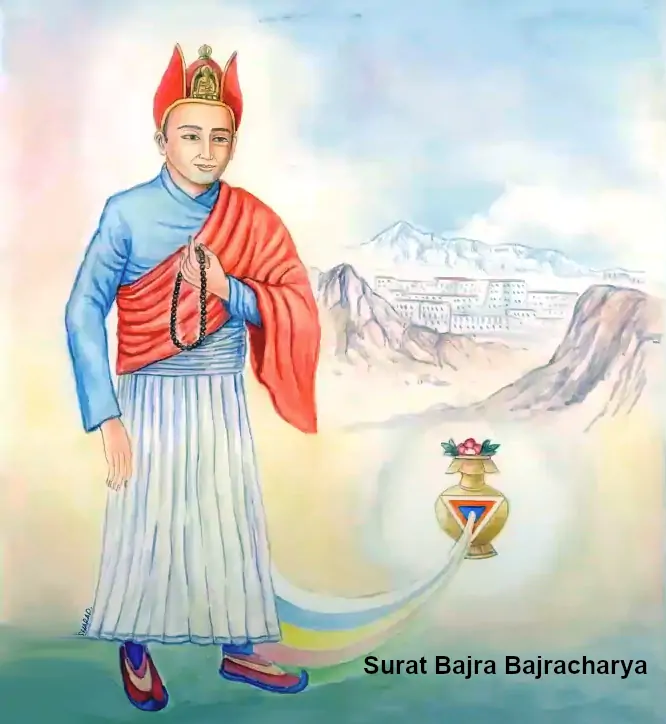Surat Bajra Bajracharya: The Great Mahasiddha of Kathmandu Valley
Surat Bajra Bajracharya, also written as Surat Vajra Vajracharya, in Sanskrit सुरत बज्र बज्राचार्य, Surat (सुरत) means “good conduct”, “virtue” or “love”, is one of the most popular Bajracharyas in the Kathmandu Valley. He is one of the four most renowned Bajracharyas, respected in the Newar community as a Mahasiddha, which means a master with extraordinary spiritual powers. Surat Bajra was a master of Vajrayana Buddhism, a branch of Buddhism that uses complex rituals and symbols for meditation and spiritual transformation. He was also skilled in tantric practices, which involve deep meditation and understanding of both spiritual and material realms. His abilities and wisdom gained him great respect in his time and among later generations.
A Life of Spiritual Legacy and Influence in Kathmandu and Lhasa
Surat Bajra was born during the rule of the Malla kings in Nepal. Many believe he was born in the 16th century, specifically during the reign of King Shiva Simha Malla (1578–1619 CE). This era is known for its legendary “Tales of ShimSim Raja,” which feature heroic and magical events that have become part of the region’s cultural heritage. However, others suggest that Surat Bajra was actually born in the 14th century, during the reign of Jayayakshya Malla, also known as Yaksha Malla (1428-1482 CE). This theory is based on a 1490 CE inscription in Bhaktapur, dated to Nepal Sambat 611, which records that Surat Bajra’s son, Jeeva Bajra Bajracharya, was invited to Bhaktapur. It’s possible that Surat Bajra was born in the 14th century but became widely known in the 16th century due to the legends surrounding him. Regardless of the exact time, Surat Bajra’s life remains closely tied to this legendary period, and his spiritual path added depth to the traditions of his community.
He was from a place called Takse Bahal (तक्ष बाहा:), also known as Surat Shree Mahavihar (सुरतश्री महाविहार), located in Asan Tole (असन टोल) in Kathmandu ( See in Map). Not only did he live in Takse Bahal, but he is also believed to have established it as a center for religious practice. To honor him, the place was named Surat Shree Mahavihar, connecting his name with this significant religious site. During his life, this vihara became a center for the teachings of Vajrayana Buddhism and tantric practices. Under his leadership, it became a respected place for spiritual learning, drawing students and followers who wanted to study his teachings and follow the spiritual path he set out.
Surat Bajra Bajracharya is believed to have spent part of his life in Lhasa, Tibet, where he reportedly defeated the Dalai Lama in a debate and practiced Nairatma (Guheswari) meditation in a nearby cave. Traders traveling to Lhasa have confirmed that this cave still exists, and sources say that Tibetans traditionally visited Takse Bahal in Kathmandu to pay homage to their revered guru, Surat Bajra.

The Miraculous Fire: A Tale of Spiritual Power
Surat Bajra: Journey to Lhasa Tibet
Surat Bajra was a revered Buddhist priest from Nepal, known for his wisdom and mysterious powers. One day, he journeyed to Lhasa, Tibet, where he had an unusual encounter with a great Lama. As they sat together for tea, Surat Bajra did something strange: he silently poured his tea onto the floor, only to refill the cup and pour it out again. Surprised by this odd behavior, the lama asked him why he was wasting the tea. Surat Bajra’s answer was even stranger. He calmly explained that his house in Kathmandu, Nepal was on fire at that very moment, and by pouring out the tea, he was putting out the flames.
The lama was puzzled but didn’t question him further. However, he made a mental note of the time and date of Surat Bajra’s actions. After Surat Bajra left, the lama sent a messenger to Nepal to verify the story. Months later, the messenger returned with an incredible report: Surat Bajra’s house had indeed caught fire at the exact time he mentioned, but miraculously, a timely rain had saved it. The lama, though skeptical, could not help but feel both awed and jealous of the Nepalese priest’s powers.
A Clever Plan by the Lama
Later, when the lama learned that Surat Bajra was preparing to return to Nepal, he grew angry and jealous. Determined to stop him, the lama sent word ahead to Nepal, falsely reporting that Surat Bajra had died on his way back from Lhasa. The lama also instructed that no boatman should take Surat Bajra across the Brahmaputra River. However, Surat Bajra was not an ordinary man. Despite the lama’s cunning plan, he found a way to continue his journey.
Frustrated, the lama decided to challenge Surat Bajra to a contest of knowledge, believing this would be the perfect way to prove his superiority. He approached Surat Bajra with a proposal: the two would transform into sparrows and perch on a stalk of wheat growing on the roadside. The one whose stalk bent under their weight would lose. Surat Bajra agreed.
The Contest of Knowledge Between Surat Bajra and Lama
The two men transformed into sparrows and perched on the wheat stalks. To the lama’s surprise, his stalk bent heavily under his weight, while Surat Bajra’s stalk remained straight and unbent. To demonstrate that his sins were not as heavy as the lama’s, Surat Bajra transformed himself into a larger bird, a pigeon. However, the stalk of wheat still did not bend under his weight.
In a fit of rage, the lama changed himself into a hawk, a predator of pigeons, and swooped down to attack Surat Bajra. The pigeon, though, quickly fled into a nearby cave, where he regained his human form. The lama, not willing to admit defeat, transformed into a snake and crawled after him. Cornered in the cave, Surat Bajra called upon the goddess Guhyeśvarī for help. The goddess granted him a sword, with which Surat Bajra defeated the snake, cutting it into pieces.
The Final Journey Back to Kathmandu
Surat Bajra, victorious but weary, continued his journey back to Nepal. However, when he reached the Brahmaputra River, he found that there were no boats available, as the lama’s orders had ensured no one would transport him. Undeterred, Surat Bajra used his red robe, known as the Kashayabastra (काषायवस्त्र), as a boat. He sat on it and sang a spiritual song (चर्यागीत), Jayambachhali (जयबाच्छली), as he crossed the river.
Upon reaching Kathmandu, Surat Bajra learned that, due to the lama’s lies, rumors had spread that he was dead. His family had already performed the death rituals for him. Unable to return home, Surat Bajra decided to send a sign to his family that he was still alive. He removed his shoes and sent them to his family as proof of his survival.
Finally, Surat Bajra made his way to the temple of Guheswari (most probably Purano Guheswari Temple), where he entered into deep meditation and was never seen again. His disappearance remains a mystery, but his tale of strange powers, wisdom, and encounters with powerful beings lives on, leaving an enduring legend in Nepal and beyond.

Contributions to Vajrayana Buddhism and Literature
Surat Bajra Bajracharya made significant contributions to the spiritual and cultural landscape of the Kathmandu Valley, particularly in the realm of Vajrayana Buddhism and literature. He is credited with the construction and establishment of the main Chaitya at Mu Bahal, Mulashree Mahavihar. This mahavihar (monastic complex) became an important center for Buddhist practices and learning, further solidifying Surat Bajra’s influence in the community.
In addition to his architectural and spiritual contributions, Surat Bajra was a prolific writer. One of his most notable works is “Ārya Mañjuśrī Saṅgītapārthālokakara Nāma” (आर्य मञ्जुश्री सङ्गीत्पार्थालोक कर नाम), a text focused on the teachings of Manjushree, the bodhisattva of wisdom, who is highly revered in Vajrayana Buddhism. This text highlights his deep understanding of Buddhist philosophy and his ability to articulate the teachings in a way that connected to both religious and cultural aspects of Newar society.
Surat Bajra also played a crucial role in Newar spiritual poetry, specifically through the creation of Cha Chaa (चचा:). These were spiritual poems meant to inspire followers to practice Tantric Vajrayana Buddhism. The Cha Chaa are composed in musical meters and are rich in symbolism, incorporating both devotional and meditative elements to guide the practitioner’s spiritual journey. Some of the popular Cha Chaa composed by Surat Bajra include:
- Ṣodashahāyana – Lalit Rāga – Jhapa Tāla
षोदशहायन – ललित राग – झप ताल - Nābhimaṇḍala – Vibhāsa Rāga – Mātha Tāla
नाभिमण्डल – विभास राग – माथ ताल - E Mahīmaṇḍala – Bhairavī Rāga – Śani Tāla
ए महीमण्डल – भैरवी राग – शनि ताल - Jayambāñchali – Pañcama Rāga – Trihula Tāla
जयंबाञ्छली – पञ्चम राग – त्रिहुला ताल - Bhāsvara – Bhairavī Rāga – Ekatal Tāla
भास्वर – भैरवी राग – एकताल ताल - Viṣaya Viṣaya – Lalit Rāga – Jhapa Tāla
विषय विषय – ललित राग – झप ताल - Dhṛdhara – Vibhāsa Rāga – Mātha Tāla
धरधर – विभास राग – माथ ताल - Śrī Mahāmañjuśrī – Nāṭa Rāga – Jaṭī Tāla
श्री महामञ्जुश्री – नाट राग – जटी ताल - Dinamani Maṇul – Tarāvalī Rāga
दिनमणि मणुल – तरावली राग - Kalpāvasthita – Lalit Rāga
कल्पावस्थित – ललित राग - Hūmākāra Sambhava
हूंकार संभव - Sahaja Sarorūha
सहज सरोरुह
Each of these compositions was meant to invoke spiritual experiences and deepen the practitioner’s connection to the divine, especially through the practice of Tantric rituals. Surat Bajra’s Cha Chaa became an integral part of Newar Buddhism, combining devotional practice with deep musical and poetic traditions. His influence on Vajrayana Buddhism and Newar literature continues to resonate in the Kathmandu Valley to this day.
Concluding Tribute
Surat Bajra Bajracharya (Surat Vajra Vajracharya) stands as a towering figure in the history of Vajrayana Buddhism and Newar culture. His life and work were a testament to his deep spiritual wisdom, mastery of Tantric practices, and commitment to the preservation and transmission of Buddhist teachings. From his establishment of key Buddhist institutions like Mu Bahal to his creation of sacred texts and spiritual poetry, Surat Bajra’s contributions have shaped the religious and cultural landscape of the Kathmandu Valley for centuries.
His legacy lives on not only through his architectural and literary works but also through the practices and rituals he inspired within the Newar community. Surat Bajra’s profound understanding of Buddhist philosophy and his ability to express it through both scholarly texts and devotional poetry continue to influence spiritual seekers and practitioners today. His journey from a humble Buddhist priest to a revered Mahasiddha embodies the transformative power of wisdom, meditation, and devotion, marking him as one of the most important figures in the history of Newar Buddhism and spiritual thought.
Frequently Asked Questions
1. Who was Surat Bajra Bajracharya?
Surat Bajra Bajracharya was a highly respected Buddhist priest and Mahasiddha from the Kathmandu Valley. He is celebrated in the Newar community for his expertise in Vajrayana Buddhism and tantric practices, and his spiritual contributions to his community.
2. What does the name “Surat Bajra” mean?
In Sanskrit, “Surat” (सुरत) means “good conduct,” “virtue,” or “love,” while “Bajra” represents the thunderbolt symbol of Vajrayana Buddhism. His name reflects his virtuous character and connection to Buddhist teachings.
3. When did Surat Bajra Bajracharya live?
Though traditionally believed to have been born in the 16th century during the reign of King Shiva Simha Malla, some historical inscriptions suggest that he might have been born in the 14th century during King Jayayakshya Malla’s rule.
4. Where did Surat Bajra Bajracharya reside?
He lived in Takse Bahal, also known as Surat Shree Mahavihar, located in Asan Tole in Kathmandu. This area became a respected center for Vajrayana teachings and tantric practices under his guidance.
5. What are some of Surat Bajra’s contributions to Buddhism?
Surat Bajra established the main Chaitya in Mu Bahal (Mulashree Mahavihar) and wrote important texts, including the Arya Manjushri Sangeet Parthalok Kara Naam. He also composed Newari spiritual poems called Cha Chaa, which promote tantric Vajrayana practices.
6. What is the significance of Surat Bajra’s time in Tibet?
Surat Bajra is said to have spent time in Lhasa, where he reportedly debated with the Dalai Lama and meditated in a nearby cave. This cave is still believed to exist, and Tibetan followers have historically visited Takse Bahal in Kathmandu to honor him.
7. Why is Surat Bajra considered a Mahasiddha?
A Mahasiddha is a revered spiritual figure who has achieved extraordinary powers through intense meditation and spiritual practices. Surat Bajra’s mastery of Vajrayana Buddhism and tantric knowledge earned him this title, highlighting his influence and spiritual accomplishments.
8. Are there any legends associated with Surat Bajra Bajracharya?
Yes, several legends surround his life, including his ability to perform remarkable feats and his spiritual wisdom. These stories contribute to his mystical legacy and the cultural heritage of the Kathmandu Valley.
9. How did Surat Bajra influence Kathmandu’s culture and spirituality?
Through his teachings, writings, and establishment of Takse Bahal as a center of learning, Surat Bajra enriched Kathmandu Valley’s religious and cultural landscape, inspiring future generations of practitioners and followers.
10. Does Surat Bajra have any children?
Yes. Surat Bajra had one son named Jeeva Bajra Bajracharya. Like his father, Jeeva Bajra was a master of Vajrayana Buddhism and became one of the most respected Bajracharyas in the Newar community.
11. What does the word “Tantric” mean?
The term “Tantric” comes from the word Tantra, which means technique. A Tantric is someone who uses specific techniques or methods to solve problems efficiently and effectively.
12. Is it true that Tantrics are magicians or perform supernatural acts?
No, that is a myth often perpetuated by movies and popular media. A Tantric is not a magician but someone who applies methods for practical and spiritual purposes.
13. Why do some people associate Tantrics with fraud or superstition?
Like any field, there are fraudulent individuals who misuse the title for personal gain. This has led to misunderstandings about what Tantrics truly represent.
References
- Prasiddha Bajracharya, Badri Ratna Bajracharya, 1988
- The History of Ancient and Medieval Nepal, D.B.Shrestha & C.B. Singh, 1972
- Buddhism in Nepal, Badri Ratna Bajracharya, 2009
- Newars and Tibetans in the Kathmandu Valley, Ethnic Boundaries and Religious History, Todd T. Lewis, 1989
- Buddhist Monasteries of Nepal, John K. Locke, 1985
- Art of Surat Bajra Bajracharya, Sarad Shakya, Shantipur Magazine Edition 3

